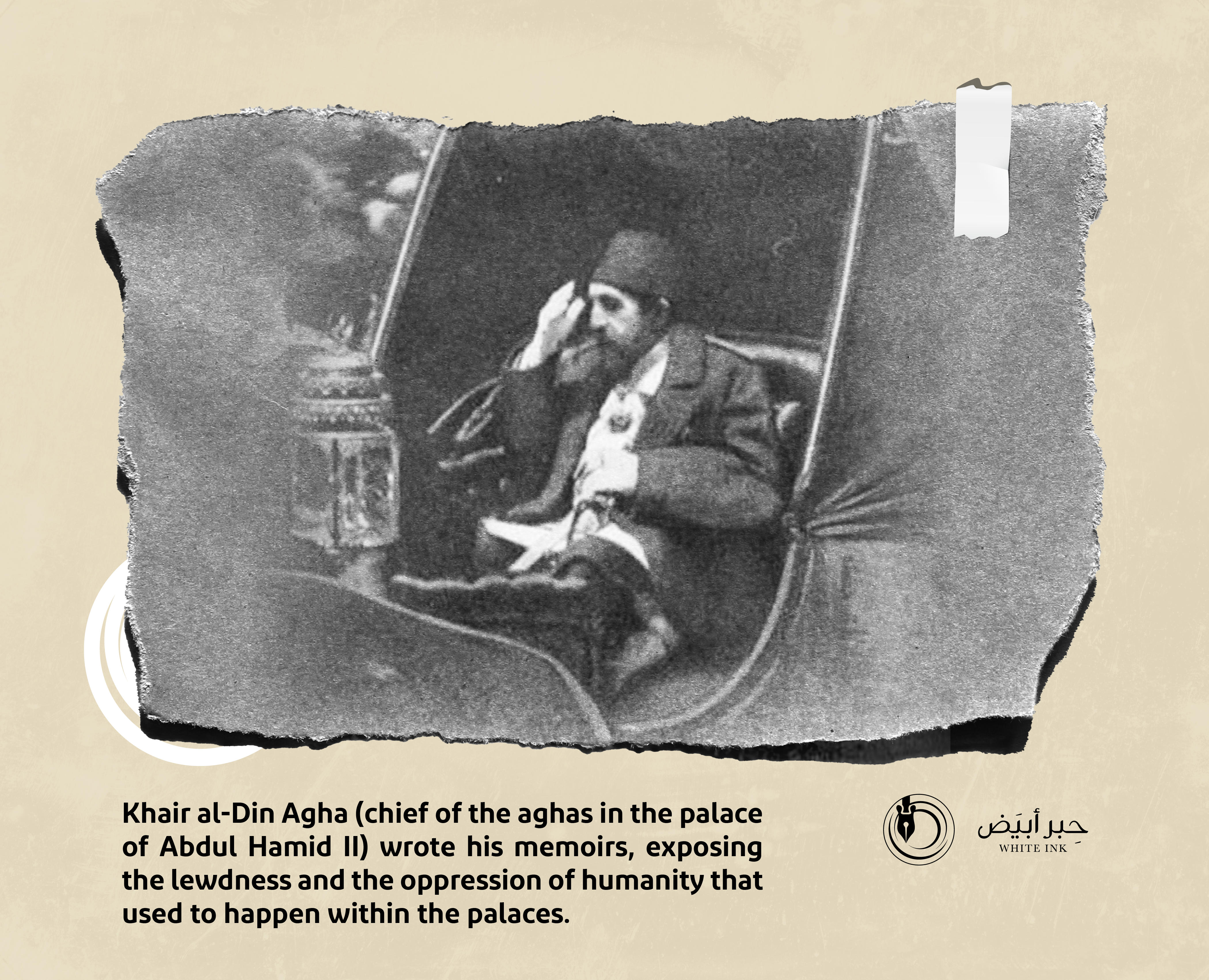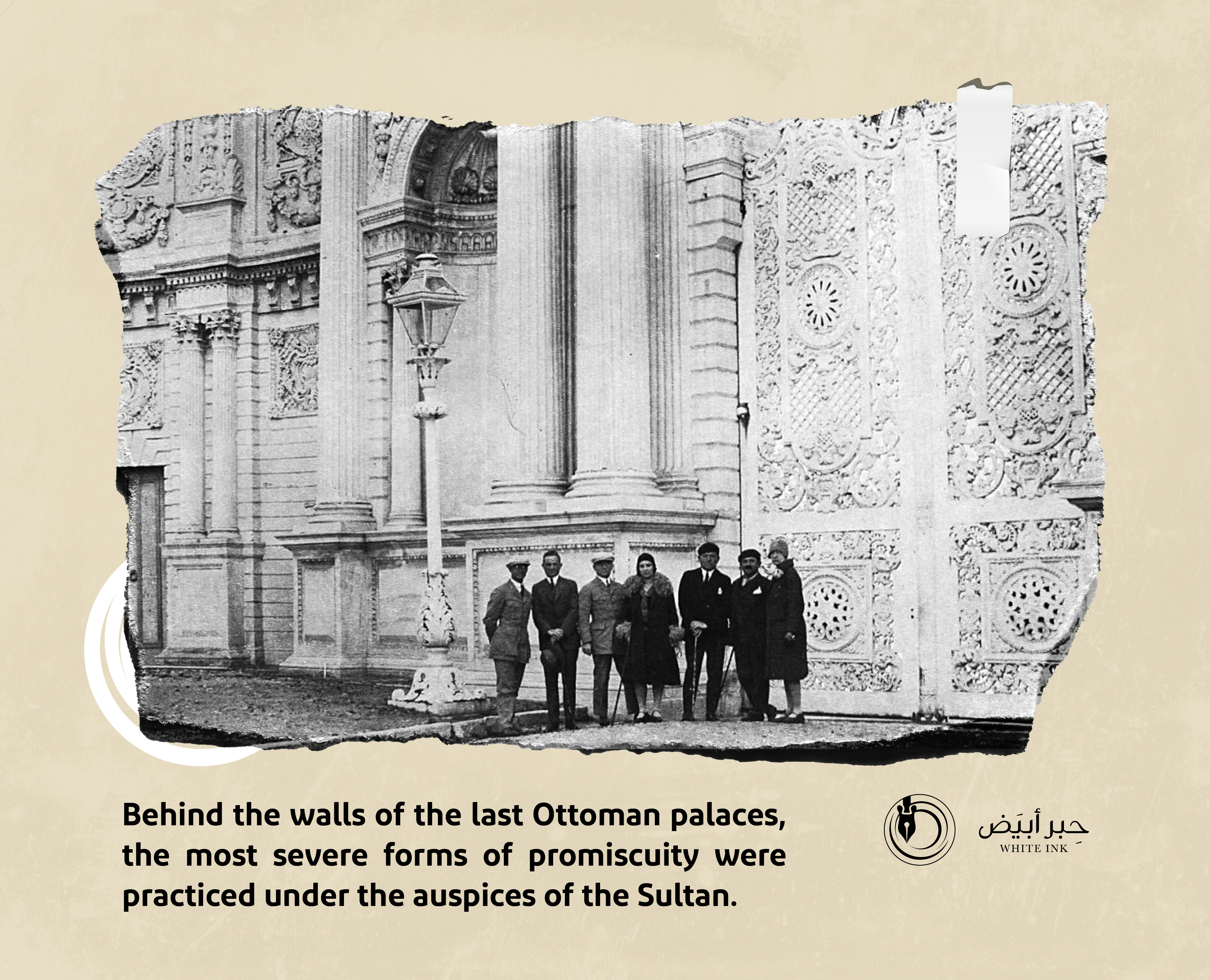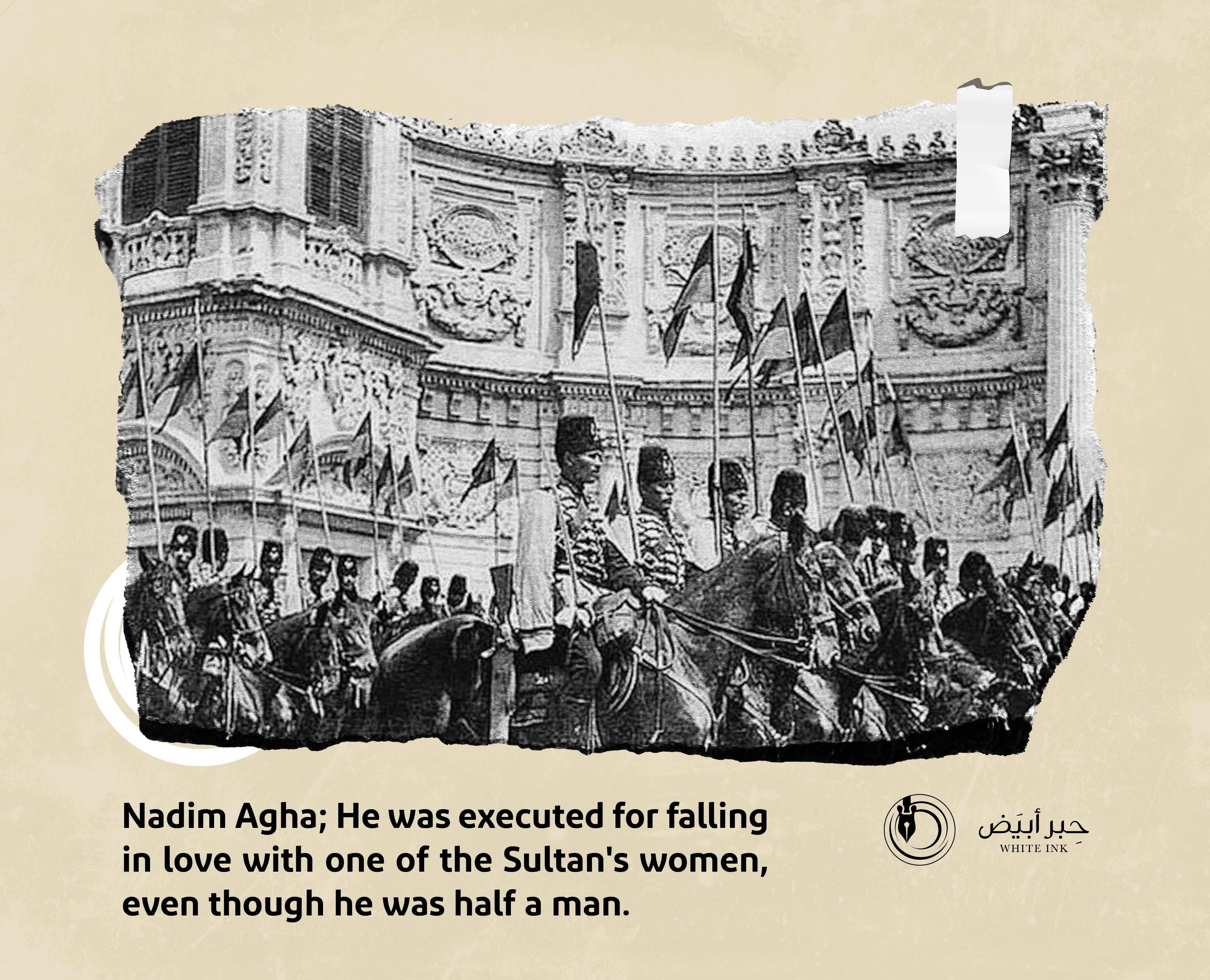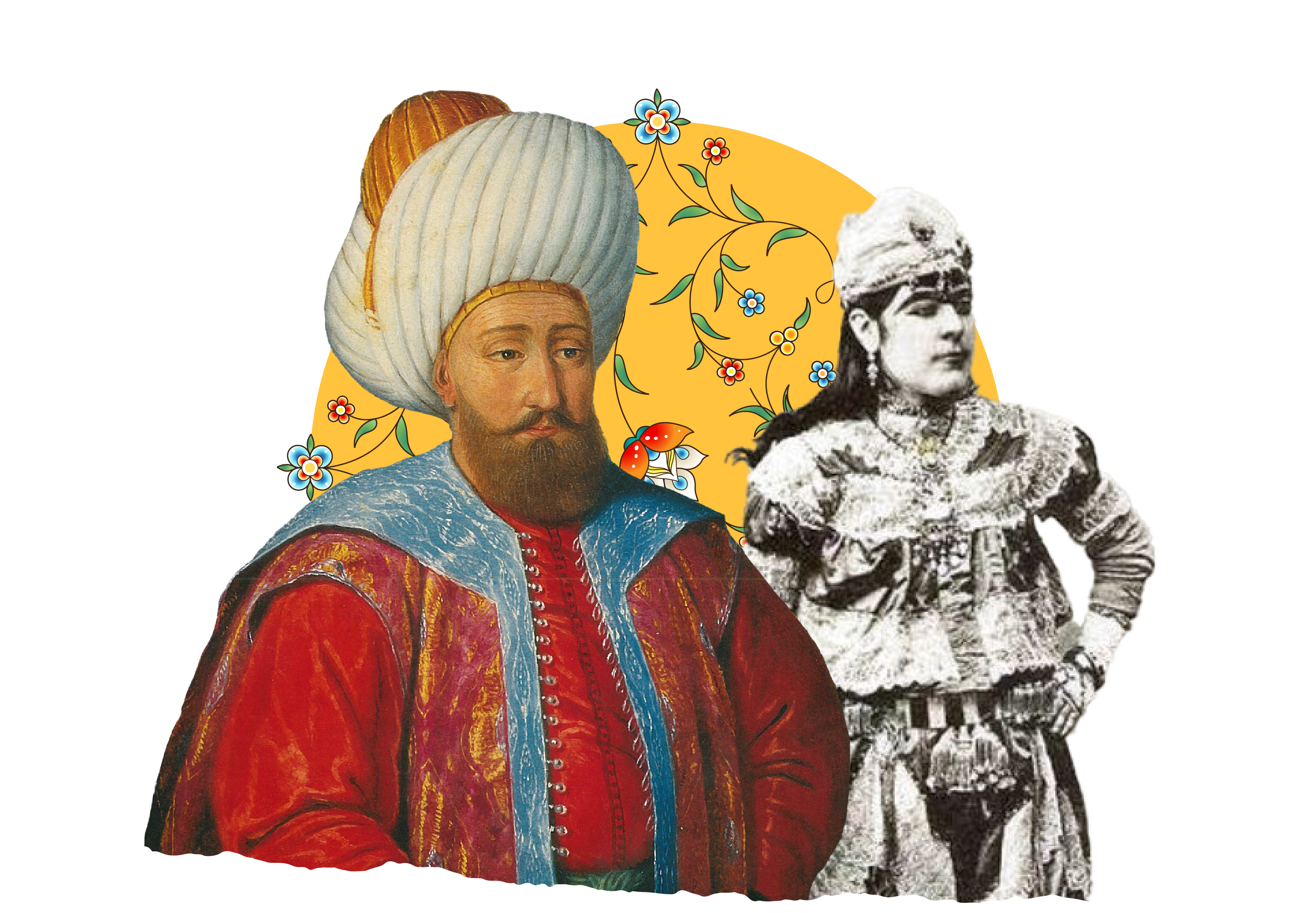
They explicitly violated the Islamic Principles
The Ottomans legalized “Homosexuality” before Europe,
in 1858 AD
Some of the Ottoman sultans were tyrannical, as some of them even went against human instinct, when they jumped to power in a moment of decline in the Islamic world and suddenly became rulers, in their hands lies the fate of Muslims, they believed that they could do what they wanted without history holding them accountable for their crimes.
One of the genuine facts about the sultans of the Ottoman Empire, is that they lived in secrecy and mystery, believing that no one would know what they were doing inside their palaces, and who were close enough to the Sultan and influencing the lives of millions of people? whoever dares to reveal this secrecy and mystery, his fate is to be put to immediate death, and how much the Ottoman family squandered the blood of some people for trivial reasons.
As time shall reveal the facts that many of the Ottoman sultans tried to withhold from the people, most of these facts that were discovered by or revealed to the historians and were written about, were traumatic, and often the scenes were more heinous than anyone ever imagined, the mystery and secrecy were nothing but a barrier to avoid discovering that the palaces of Ottoman family – in most periods of their rule – are nothing more than arenas in which immoral acts are engaged, aberrant parties are held where the human soul is insulted with the most basic despicable desires. Some may think that talking about these matters is a kind of denial by historians against the Ottoman Empire, but the truth is that historians found nothing in the palaces of the Turkish sultans, but vice and slavery.
The most prominent point presented in the historical sources is that some of the Turkish sultans had tendencies beyond just women. This appeared early in the Ottoman Empire, whose sultans worked to get close to the Bektashi Order, which allowed its top figures to be deviant as part of the Sufism rituals. On the other hand, the top figures of the Bektashi Order found that their proximity to the Turkish sultans would benefit them, so they considered the Ottoman family to be among the top figures of the Bektashi Order and permitted them what transgress human instinct, as a means of spiritual advancement and receiving spiritual assistance from heaven, in the worst types of exploitation of religion in the most distorted way.
After this manipulation, the Turkish sultans set out to establish an entire institution for such shameful purpose. It started during the reign of Sultan Bayezid I (1389-1403), who was known for his penchant for men and the participation of his minister Jandali Ali Pasha in organizing promiscuity parties in which boys were brought to Bayezid I, and many of these adolescent boys became – later – senior statesmen until a proverb spread within the Ottoman Empire that only those who were known in those disgraceful parties that violate common sense rise to positions.
The French writer, Philip Mansel describes in his book “Constantinople, City of the world’s desire” that the palace of the sultan in the Ottoman Empire was a self-standing world. As for the adolescent boys, they had to go through joining rituals and ceremonies, described by “Mansel” as when a new adolescent boy enters, he is to be left alone for three days without anyone talking to him until the chief of the Aghas informs him that he has joined the ranks of the Sultan’s servants.
As for the appearance of these adolescent boys, their hair was combed and divided into braids near their ears and they were treated like dogs tied with a leash around the neck, and if they violated a rule, they were severely beaten. As for the most handsome forty boys, they were chosen to serve in the Sultan’s private room, and their beds were distributed to the four corners of the room; in such place all the sins that violate common sense were committed.
These adolescent boys were then given names of flowers; such as, Narjes and Ward, all of which have feminine connotations, and they were forced to learn to play music, dance, put on cosmetics, and wear dance suits like women.
They forced the adolescent boys to wear women’s clothes.

Atviano Bonn, Italy’s ambassador to the Ottoman Empire during (1604-1608), reveals in his book, which was published in the middle of the seventeenth century AD, “Saray al-Sultan”, that the relationship of the Ottoman sultans with some adolescent boys did not go unnoticed. Sultan Mehmet al-Fateh (1444-1481) had a relationship with one of the adolescent boys, that relationship continued until people started whispering about it, but none of them could say anything for fear of being killed, despite that, “Al-Fateh” did not care about any whispers and his relationship continued.
As for the details of that relationship, it goes back to the year )1433( when Sultan Murad II managed to defeat the Emir of Serbia and took 70,000 captives, among whom were two sons of one of the leaders collaborating with the Emir of Serbia, whose names were “Flatobs” and “Radu the handsome”, and when Mehmet Al-Fateh took over, succeeding his father, he released “Flatobs” but he kept “Radu the handsome” and grew feelings for him, and a relationship developed between the two of them that lasted for many years, which led historians to describe Mehmet Al-Fateh as a person full of contradictions.
“Al-Fateh” was not satisfied with that, aside from his relationship with “Radu the handsome” he was choosing the most beautiful kidnapped children from Europe to work in his room, it even came to the point that he forced his adolescent boys to wear the veil after being possessed by jealousy over them, which indicates that, going against human instinct nature was prevailing in the Ottoman palace.
At a time when the whole world forbade homosexuality, and Islam forbade it with explicit and clear texts, it was Mehmet Al-Fateh who legalized immorality by abolishing the punishment of “sodomy”. He considered sodomy to be permissible with handsome boys, who were considered as a proof of the beauty of God’s creation!
Al-Fateh jealousy on his adolescent boys made him force them to wear veils

As for Murad IV (1623-1639), he was the weirdest among the Turkish sultans, not because he was not straight, but the fact that he claimed virtue and honor; so, he pursued after the coffee drinkers, prohibited it, and whipped the drinker, and he maintained his mustache in specific form in order to look strong and majestic. This was no more than an attempt to make up for what he felt missing, as historical documents revealed that Murad IV was in love with a boy named Musa Çelebi; and the Ottoman capital was aware of that and locals were making jokes about it in their private gatherings.
Salim II (1566-1574) who was known as a drunkard, took the same path; aside from his addiction to alcohol, he kept for himself about 1,500 of the most handsome adolescent boys and Aghas. He even gifted one of his adolescent boys a palace where they met periodically, at a time when millions of Muslims were starving due to poverty they sank in under the reign of the Ottomans, the reign of that drunkard in particular.
Some of the Ottoman sultans dealt with such violation of human nature with leniency, and homosexuality spread among the Turks in different periods of their history. Things took a general dimension in the Ottoman capital “Istanbul”, where homosexuality was implicitly supported, as if the poverty and oppression of the residents of the capital were not enough to drag them into this quagmire, by removing all obstacles and making homosexuality accepted in the society.
As a result, public baths and bars turned into dens, and their owners poked around slave markets promoted by the Turkish sultans, purchasing the most handsome boys, especially children coming from Europe.
This Ottoman phenomenon of violating human nature did not only affect people religiously, but also socially. Princess Fatima Sultan’s letter that she sent to her father, Salim I, complaining about her husband, Mustafa Pasha, who got dragged into homosexuality, saying, “Oh my father, the Sultan, I got fed up.” I married a person who cares for nothing but having sex with boys and spending his time with them; while me being treated less than a dog”. This message was considered by historians as the mouthpiece of many women in many periods of the rule of the Ottoman Empire after they felt threatened in view of the worsening of such violation to human nature.
As for AbdulMajid I (1823-1861), he went too far when, in the year (1858), the Sultan approved homosexuality by a decree “Ferman” that abolished any punishment for homosexuality, as it was of no effect or importance, but under this decree “Ferman” it became more official, places for that purpose were opened.
Under this law, the Ottoman Empire had preceded many European and Western countries in legalizing homosexuality. In Britain homosexuality was legalized among women in 1886, nearly 3 decades after the Ottoman Empire, and in Italy homosexuality was decriminalized in 1890, 32 years after the Ottomans decriminalized homosexuality. This legislation remained valid even after the foundation of the modern Republic of Turkey and up until this day, so the only thing in which the Ottoman Empire preceded the whole world was slavery and propagation of immorality and depravity.


- Philip Mansel, Constantinople… City of the world’s desire 1453-1924, translated by: Mustafa Kassem (Kuwait: Alam Al-Maarifa, 2015).
- Atviano Bonn, Saray Al-Sultan, translated by: Zaid Al-Rawadiya (Abu Dhabi: Kalima Project, 2014).
- Ahmed Abdel Rahim Mustafa, On the Origins of the Ottoman History, 2nd Edition (Cairo: Dar El-Shorouk, 1986).
- Legitimizing “homosexuality” . from the Ottomans to the Brotherhood – Okaz newspaper, Friday, July 10, 2020.
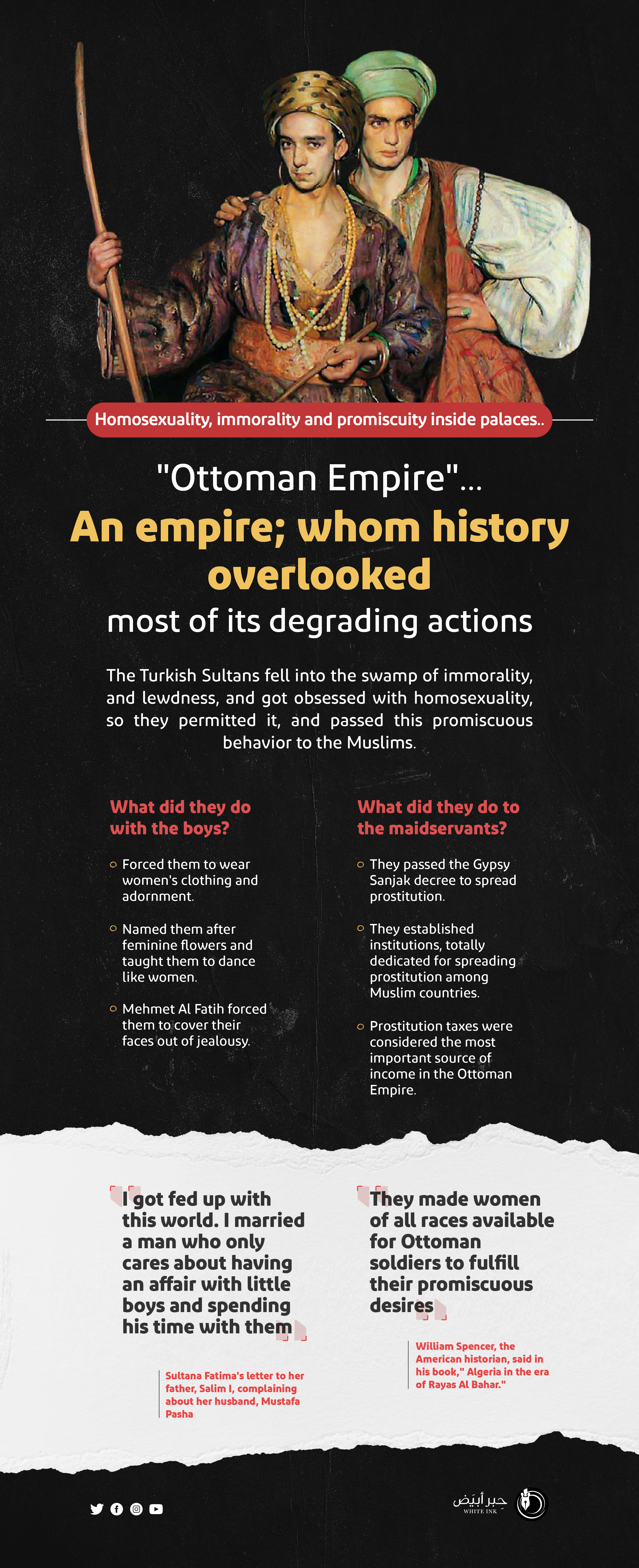
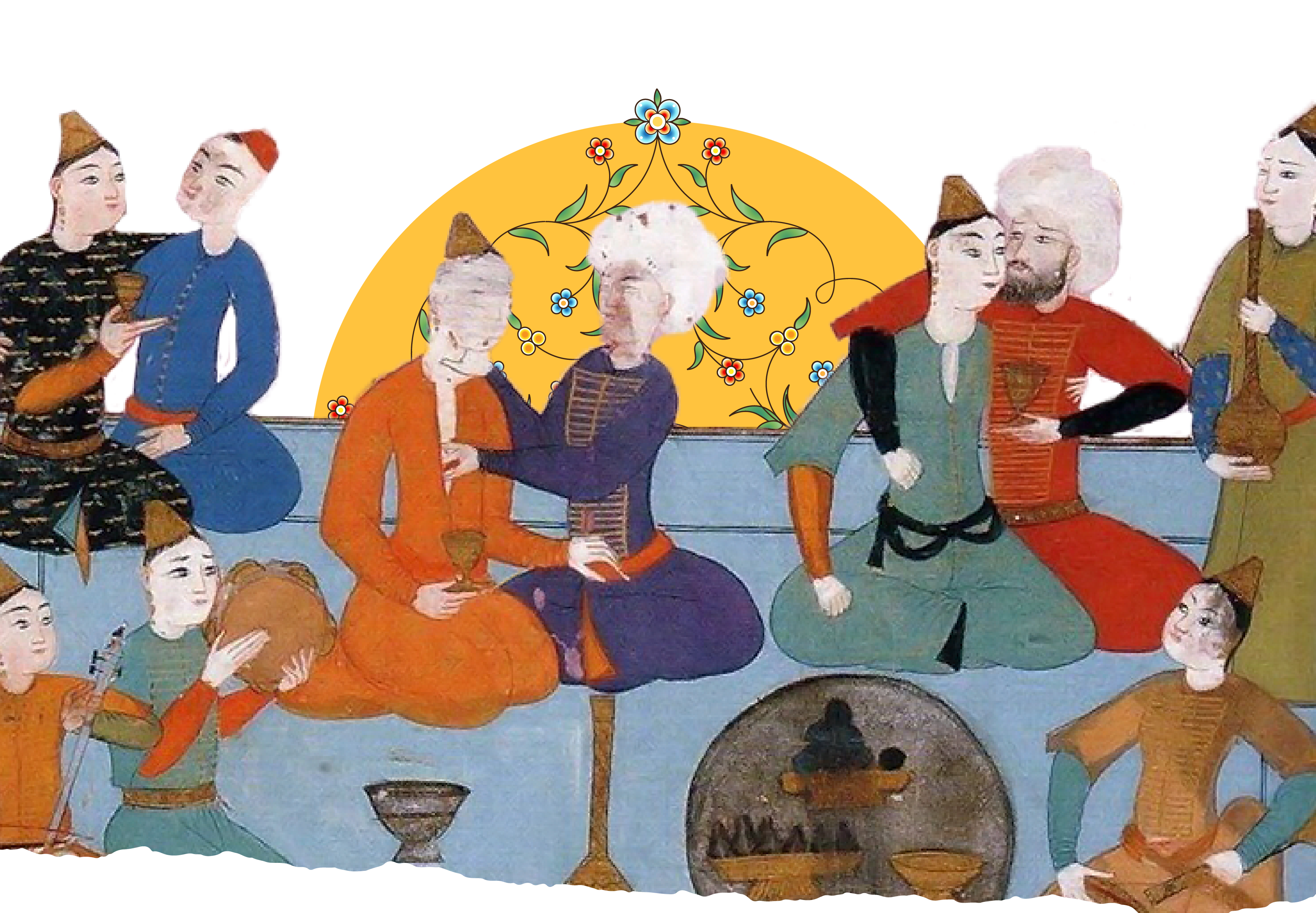
Having the unspoken within the Ottoman “Haremlik” revealed
What is the “Triad” of violation of human instinct
Linguistically, the word anomaly means congenital malformations and deviation from common sense, and describing the “Ottoman” Empire as an abnormal state is nothing more than a true description of some of the Turkish sultans.
Anomalies in the Ottoman Empire are not limited to the violation of common sense or even the laws of the countries that preceded and followed them, but the entire system violated what is normal, whether in terms of humanity by establishing the first institutions of slavery; entirely to enslave humans, or through social systems that had one purpose which was to starve people and impoverish them, up to the murder laws they legislated, so they killed their brothers and sons before they shed the blood of Muslims.
Therefore, revealing the mystery of the Haremlik and the transformation of Haremlik by the Ottoman sultans into an arena in which they committed acts against common sense, is nothing more than a part that completes the whole picture of the Ottoman family.
Despite the fact that the Turkish sultans, when they established the Haremlik as a private place reserved for their women and maidservants, did not just impose complete secrecy and strict laws, but they also killed every strange man who tried to get a glimpse of what was going on in this mysterious part of the Palace. In the end, the historical documents that revealed everything appeared.
These documents elucidated that deviation from common sense, dominated the three elements of the Haremlik: Children, Maidservants and customs of the Haremlik.
As for the children, the Italian ambassador to the Ottoman Empire, Atviano Bonn, was the first to reveal the abnormal actions that went against common sense within the Haremlik, in his book “Saray al-Sultan” published in the mid-17th century. Bonn shed some light on the slaves and children who were castrated as a condition for working inside the Haremlik. He says that the Turkish sultans called these eunuchs children with names of flowers such as Ward, Narjes, and Cronfol, such names have feminine connotations that the Ottoman family insisted on.
The Ottomans forced the children of the Haremlik to have names with feminine connotations

But what Atviano Bonn mentioned is only an introduction to heinous behaviors, and scenes that are only narrated in tales; as the historical sources reveal, the Ottoman sultans invented the “Kojic” phenomenon since the sixteenth century, which means young children who are raised and trained to dance in an erotic way. They are forced to wear women’s clothes and put on cosmetics. Their clothes consisted of a red embroidered velvet jacket, loose-fitting trousers with a long skirt and a gold belt.
These children were subjected to the vile desires of some of the Turkish sultans almost daily in the Haremlik. Consequently, many of the “Kojic” suffered psychological disorders as a result of being forced to go against their instinct.
If this was the case of children and adolescent boys, then maidservants were not better off, as the historical sources were filled with narrations about the maidservants of the Turkish sultans and how they became wives, but the question that many did not ask is what about the maidservants who did not please the Sultan.
The Kojic phenomenon is an indication of the immorality of some sultans.

Historical narrations state that the Turkish sultans were not satisfied with the enslavement laws imposed on the maidservants within the Haremlik, so they issued the first law in the world to punish a maidservant if not accepted by the sultan. The Ottoman sultans devised a law that stipulated that the maidservants who did not please the Sultan were gathered in close quarters where they spend their lives with each other until death.
This perverse law was the reason why thousands of maidservants spent their lives inside closed chambers knowing no one and known by no one, deprived of the most basic rights of slaves, and in the end their dreams were killed and their lives ended with no caring in the least, from the sultans for their lives. Those sultans saved no effort in creating colors of slavery and they also went one step beyond normal.
Moreover, the depraved parties that were held by the Turkish sultans inside the palaces, where all scenes of immorality and depravity took place. It suffices to say that the Ottomans were the first to invent large basins filled with milk in which the maidservants would sit before the Sultan came to bathe, and because some of the maidservants did not have any relationship with men before joining the Haremlik, these scenes have them suffering from psychological disorders; what made them psychologically unfit throughout their lives.
Ottoman sultan have no limits when it comes to depravity. Khair al-Din Agha, the chief of the Aghas during the reign of Abdul Hamid II (1876-1909), reveals in his memoirs, titled “The Secrets of the Haremlik,” that erotic poetry was written on the walls of the Haremlik, to the extent that some Western historians were ashamed to write down everything that was written on those walls because it greatly exceeded their imaginations.
The third element of the triad, i.e., the Haremlik customs, which were also described as abnormal and out of the ordinary, the Italian Atviano Bonn narrates in his book “Saray al-Sultan” that the abnormality was part of the behavior of the girls in the Haremlik even in the way they eat, as it was served to them on Bulgarian leather and sofas, and they have to sit in a seductive way to tempt the Sultan; in order to see them and choose whomever he wants.
Even the feasts were not free from deviation as well, and this is evident in one of the feasts of the Haremlik called “Bayram”, in which the sultanas are given the most exquisite ornaments and unlimited luxury, but in return, maidservants suffer from poverty and hunger by them, in order for the sultans to enjoy, in a day designated by the Turkish sultans for oppression and injustice.
In all of these perverse laws, the life of immorality and depravity, and enslavement of everyone, it was not surprising that many maidservants and adolescent boys lost their minds, which is what Khair al-Din Agha reveals in his memoirs, the secrets of the Haremlik. He stated that the Turkish sultans detained thousands of workers in the Haremlik in what appears to be a psychiatric hospital due to the psychological imbalances that occurred to them as a result of what they witnessed and were forced to do. All this was kept secret until the Ottoman Empire fell and everyone knew what was going on in this mysterious part called “The Haremlik” in the palaces.
They caused thousands of the Haremlik Workers to suffer from mental illness.



- Atviano Bonn, Saray Al-Sultan, translated by: Zaid Al-Rawadiya (Abu Dhabi: Kalima Project, 2014).
- Ekmeleddin Oglu and others, The Ottoman Empire: History and Civilization (Istanbul: Research Center for Islamic History, Arts and Culture, 1999).
- Khair al-Din Agha, Secrets of the Haremlik in the Ottoman Court: Memoirs of the Chief of the Aghas in the Palace of Sultan Abdul Hamid II (Tripoli: Al-Sa’eh Library, d. T).
- Magda Makhlouf, The Haremlik in the Ottoman Era (Cairo: Dar El Afaq, 1998).
- – Muhammad Abu Azza, The Era of Sultan Abdul Hamid (Beirut: Al-Manara, 1997).
- Muhammad Jamil Byhm,Priorities sultans Turkey civil, social and political (Sidon: Al Wefaq Press, 1930 AD).
- Mohammed Suhail Taqqosh, History of the Ottomans from the State to the overthrow of the Caliphate, 2nd Edition (Beirut: Dar An-nafaes, 2008).
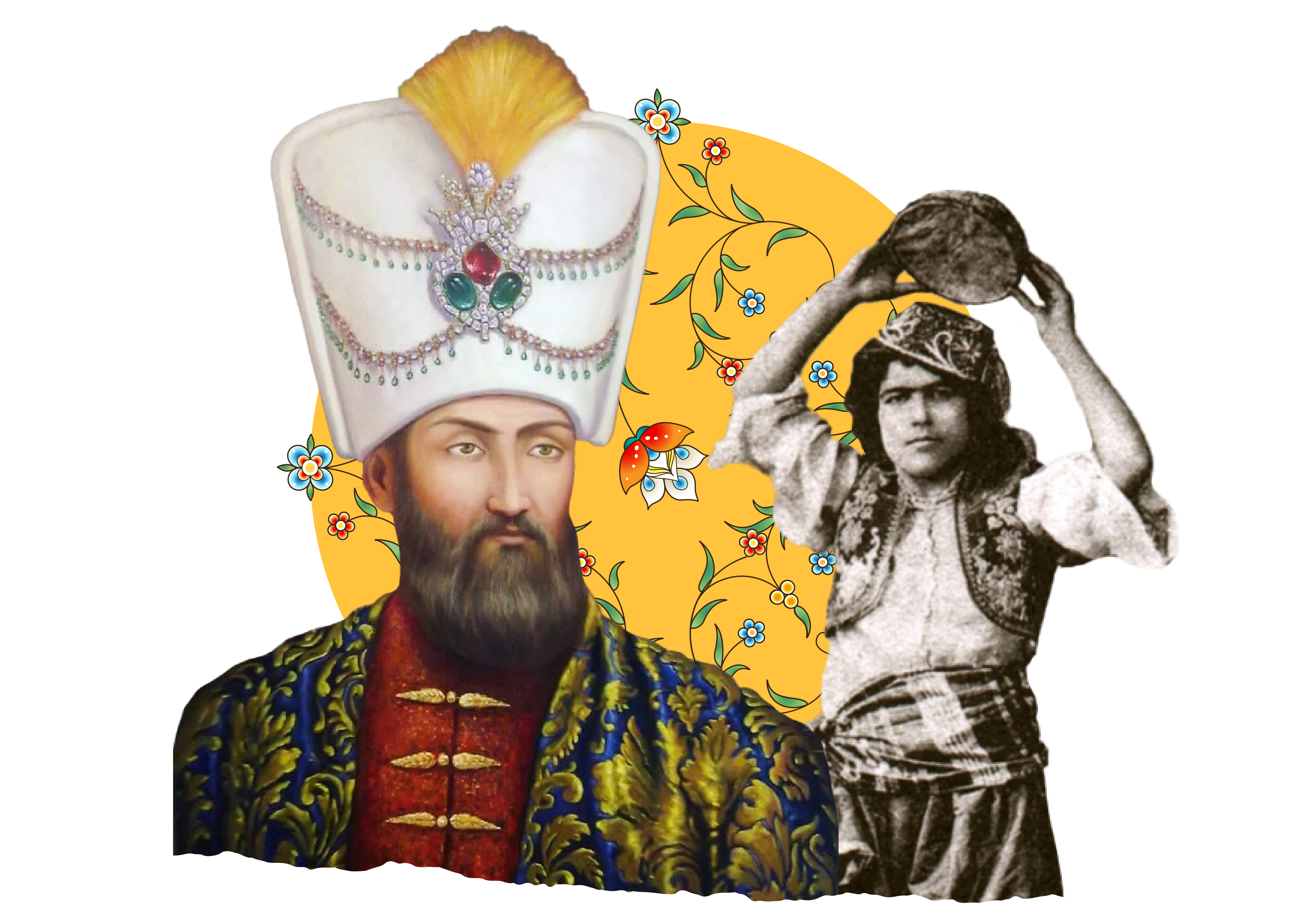
They legalized and spread Prostitution in the Muslim Countries
The Ottoman Empire...
the state that issued a legal fatwa to permit "indecency"
How can we relate what the Turkish sultans did of spreading immorality and depravity, and promoting Prostitution among Muslims and Arabs; Was it due to their decadent human nature despite their claim to rule in the name of Islam? Or was this a method followed by the Ottoman family to destroy the Arabs who despised them after the Arabs ruled the world and ruled with justice and equity?
This question where a lot of historians gazed upon, and were astonished by the extent of the Ottoman Empire’s enslavement of the human body, in spite of its claim to rule by Islam, which honored man and preserved his body and soul, and their sultans – falsely – were called “caliphs.”
Although the phenomena of homosexuality and Prostitution are as old as humanity and were witnessed by all the empires of history, but in the end, it was mere abstract phenomena reprehensible by people of common sense, and in many times those who committed these acts were punished, but the Ottoman Empire was the first to do nothing, but legalized immorality and depravity. It permitted it for all. On top of that, it stepped out and spread Prostitution, which is a broader concept than homosexuality and Prostitution.
The system of laws that permitted and encouraged Prostitution was not issued during the reign of a single sultan or a time period with specific circumstances, as a matter of fact, many of the Turkish sultans participated in this, which prompted historians to consider that the Ottoman family members were the sultans of Prostitution in word and deed.
Suleiman the Magnificent (1520-1566) legalized Prostitution according to a fatwa issued by his state mufti Abu Al-Saud Effendi in (1531), completing the journey of Mehmet Al-Fateh (1444-1481) in abolishing the punishment of sodomy, and in a late period the reign of Abdul Majeed I (1823-1861), who ordered the opening of brothels for homosexual acts without any penalty.
Suleiman the Magnificent issued the first law to permit Prostitution

As for the means used to legalize Prostitution during the reign of Suleiman the Magnificent, it is by going back to the historical contexts in the year (1531) where the Gypsy tribes rebelled against the Turkish sultans; and to contain this crisis, as mentioned by the historians “Ahmet Akgündüz and Said Ozturk”, two of the most prominent defenders of the Ottoman family, in their book. “The Anonymous Ottoman Empire.” Suleiman the Magnificent resorted to founding the “Gypsy Sanjak,” a law requiring the formation of Gypsy military battalions under the jurisdiction of the Gypsy ruler, which was later known as the “Gypsy Law in the Rom Eli Eyal.” This law included – for the first time – the imposition of taxes on the illegal sexual practices of Gypsy women, which was the first official legalization of Prostitution. Fees at the time amounted to one hundred akçe per month from Gypsy women.
Despite the attempts of the historians “Ahmet Akgündüz and Saeed Ozturk” to bring into view that the legalization of Prostitution was due to certain circumstances that forced the Turkish sultans to take such decision, the incidents that occurred thereafter states: This is not true and that spreading depravity was only a methodology among the Turkish sultans, after they made their country full of bars and brothels, they began to promote this in the Arab world.
Historical sources refer to the grounds led to this Ottoman act, including that they intended to force Prostitution into the community, dismantling the unity of the Islamic family and spreading disintegration and immorality as a prelude to controlling everyone; in addition to creating a new generation that is only interested in pleasures and satisfying desires, something that ultimately serves their interests. As confirmed by historical narratives, this was one of the reasons for the weakness of the Arab world until the twentieth century, before the Turks were expelled from it.
The Levant was the closest and largest arena where the Ottoman Empire’s pashas were able to spread abnormal phenomena, and as the Syrian historian Ahmed Al-Budairi explains in his book “Damascus Daily Incidents”, in the era of the Ottoman Empire “corruption increased, People were oppressed, and shameless and senseless prostitutes increased in the markets at night and day.”
The influence of prostitutes was evident, despite living in a conservative societies such as Levant, but in the end, they were protected by the Turkish sultans who did not care about anyone, and “Al-Budairi” narrates that there was one of the prostitutes who fell in love with a Turkish boy then that boy got sick, so she vowed to herself if he recovered she will throw him a party, and when the boy recovered, the prostitutes of the country gathered and walked in the markets of the Levant, carrying candles and lanterns, singing and clapping their hands, so the people were only shouting “God is great,” meaning that God is able to rid them of the Ottoman family, the sultans of Prostitution.
Instead of the Turkish sultans concentrating on the borders of the country and securing them, and providing a safe life for Muslims; they assigned military contingents whose mission is to supervise Prostitution, and this what happened in Cairo, as the Ottoman historian Evliya Çelebi elucidate, whose book “The Journey to Egypt, Sudan and Abyssinia” reveals that the profession of Prostitution that was brought by the sultans of the Turks in Cairo, was carried out under the supervision of the Ottoman military contingents of Ojaqs, and the Prostitution networks in Cairo took an organizational form divided into prostitutes, cuckoldom and pimps.
Muhammad Niazi in his book “Crimes of Prostitution – A Comparative Study” sheds more-light on the institutions of Prostitution in Cairo, explaining that in the last quarter of the seventeenth century, prostitutes were registered in the police records and their numbers were counted, and the police kept these records, which include the names of prostitutes; women and men for tax purposes.
Abd al-Wahhab Bakr explains in his book “Cairo’s Secret Society” that there are three leaders who supervised the profession of Prostitution in Egypt, one in Cairo, the second in Bulaq, and the third in Masr El Qadeema, which are separate Egyptian regions, and they were all under the management of the police chief, which means that the Ottoman Empire adopted Prostitution as a central pillar of its rule.
Prostitution became a business from which they collected taxes.

In Algeria, another aspect to the system of prostitution among the Turkish sultans was discovered. The American historian William Spencer says in his book: “Algeria in the Era of Rayas El Bahr” that the profession of prostitution in Algeria was based on Turkish arrogance, at a time when they made women of all races available to satisfy wild instincts. For the Ottoman soldiers, they were strict in preventing the Turks from practicing this shameful act, and they put special guards on the Turks specifically to monitor them.
This racial superiority of using non-Turkish women for prostitution, eventually led to the creation of another heinous phenomenon, which is that the soldiers of the Ottoman sultans – especially the Janissaries – preferred to engage in wars in the Levant, Egypt and Algeria in order to have fun with prostitutes; as the Turkish women are forbidden to do so except with the Sultan.
Historical sources also suggest that the main tax base during the era of the Ottoman Empire was prostitution trade and slave markets that spread in all the countries ruled by the Ottoman sultans who encouraged and promoted this.


- Ahmet Akgündüz and Saeed Ozturk, The Unknown Ottoman Empire (Istanbul, Amr Turan Library, 2008).
- William Spencer, Algeria in the Era of Rayas El Bahr (Algeria: Casbah Editions, 2011).
- Ahmad Al-Hallaq, Daily Incidents of Damascus (Cairo: Arab Statement Committee Press, 1959).
- Evliya Çelebi, The Journey to Egypt, Sudan and Abyssinia (Cairo: Dar-Alafak Stores, 2006).
- Mohamed Hetata, Crimes of Prostitution – A Comparative Study (Cairo: Wahba Stores 1983).
- Abdel-Wahhab Bakr, Cairo’s Secret Society 1900–1951 (Cairo: El-Araby Foundation, 2001).


